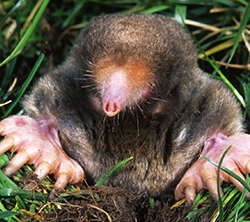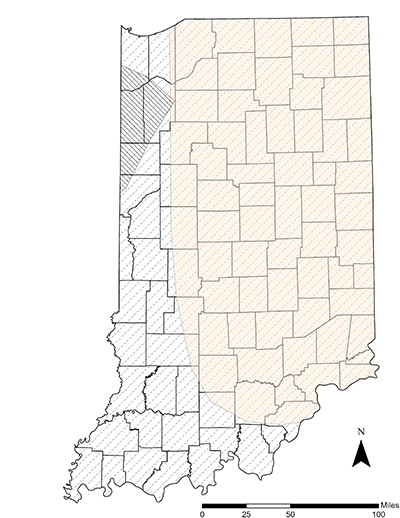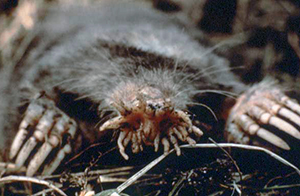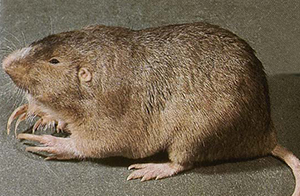EASTERN MOLE (Scalopus aquaticus) Eastern moles are highly specialized mammals with adaptations that allow them to spend their entire lives underground. Although moles dig tunnels or push up molehills, they play a vital role in improving soil quality as insect predators, nutrient cyclers, and soil aerators. Additionally, moles are an important food source for many species of mammals, reptiles, and birds. Through developing a better understanding of the importance of Eastern moles to ecosystems, we can learn to live with this species to both of our benefits.
Eastern moles are highly specialized mammals with adaptations that allow them to spend their entire lives underground. Although moles dig tunnels or push up molehills, they play a vital role in improving soil quality as insect predators, nutrient cyclers, and soil aerators. Additionally, moles are an important food source for many species of mammals, reptiles, and birds. Through developing a better understanding of the importance of Eastern moles to ecosystems, we can learn to live with this species to both of our benefits.
General Characteristics:
- Small mammals (4 ounces) and are 4-7 inches in length.
- Large, webbed forefeet that are wider than they are long, with sharp claws for digging. Small hind feet.
- No external ears and have very small eyes hidden by their fur.
- Gray fur that is extremely soft and velvety.
- Their hairless tail is 1 to 1 ½ inch long.
- The snout is cone shaped, hairless, and generally pink.
- Eastern moles are nocturnal and crepuscular, meaning that they are most active at night or morning and evening.
- Eastern moles are fossorial, meaning that they are adapted to digging and living underground.
Food Habits
Moles are insectivores, eating insects and invertebrates:
- Grubs & earthworms
- Ants & termites
- Slugs & snails
- Centipedes
- Beetles, crickets, and many others
Similar Species
Star-Nosed Mole
The unique star-shaped appendages on the star-nosed mole (Special Concern) makes this species easily identifiable. | Plains Pocket Gopher
Plains Pocket Gopher (Special Concern) can be identified by their smaller front feet, larger eyes and ears, and overall tan fur color. |
Distribution and Abundance
Eastern moles prefer loamy, well-drained soils. They avoid soil that is too wet, rocky, sandy, or heavy with clay, as these soil types make it hard for the mole to dig. Moles can be found in forests, prairies, savannas, meadows, agricultural fields, gardens, and lawns. About 1 acre of good soil habitat can support three to five moles.
Eastern moles have a wide distribution across North America. They are found primarily in the eastern half of the United States and in portions of Canada and Mexico. This species is a habitat generalist and can occur in more habitats than other mole species. Because of this, the Eastern mole is abundant across its range, including in Indiana.
Potential Distribution
|
Eastern mole |
Plains pocket gopher |
Star-nosed mole |

Reproduction
Moles will mate between January and April. After approximately 44 days, the female has a litter of three to five young. Litters are born anytime from late February through early June. Moles only have one litter a year. The young are born without fur in a plant-lined nest in one of the deeper chambers underground. They will stay in the nest until they are about four weeks old. By three months old, they are adult-size, and they can breed by the end of their first year.
Molehills
Since moles live underground their whole life, they rarely leave tracks or droppings on the surface. Their presence is indicated by the piles of recently excavated soil and tunnels that they create. They actively build two types of tunnel systems year-round: shallow hunting tunnels and deep tunnel systems.
The shallow hunting tunnels are just under the surface, 4-6 inches wide, and look like raised earth pathways. These foraging tunnels trap insects and invertebrates as they move into them. The mole then navigates these tunnels to eat, or gather and save for later, the trapped prey. The deep tunnel systems are usually 10 inches or more below ground and used for rearing young, resting, and winter hunting. When tunneling deeper in the ground, the mole pushes soil up to the surface causing molehills. The hills typically have a diameter of less than 12 inches and are five to eight inches tall. Moles prefer to dig when the soil is moist, which is why tunnels often appear after a heavy rain.
Molehills vs. Gopher Mounds
Before you take action against moles in your yard, be sure to confirm they aren’t plains pocket gophers or star-nosed moles. Both species are listed as Species of Greatest Conservation Need (SGCN) in Indiana because their distribution and abundance have declined. These two species are monitored by DNR through ongoing projects and reports are submitted by Hoosiers through Report A Mammal.
Star-nosed moles will create many of the same features that eastern moles do, but because star-nosed moles are smaller in size they will not be able to occupy areas where soil contains more clay or rocks. Additionally, star-nosed moles are semi-aquatic and will occupy habitats closer to water features.
Mole mounds are usually circular and have a plugged hole in the center, while plains pocket gopher mounds are more fan shaped with one or more holes off-center, often appearing like a crescent or semicircle. Plains pocket gopher mounds are large, 1-3 feet across and 1 foot tall, while gopher mounds are much smaller.
Tolerance
Mole activity benefits humans by providing insect control, aerating the soil, and cycling nutrients. These soil health benefits may well be worth learning new management methods for this species. By embracing coexistence, you not only contribute to the well-being of these fascinating animals, but also support a healthier, more biodiverse environment in your yard and in Indiana.
Management and Control
While molehills and tunnels can be frustrating for homeowners, it is important to remember that the species is important for maintaining soil health. Moles will not eat vegetables, roots, or flowers because they are insect eaters.
The best first step to take when managing moles is to set realistic expectations. Start any exclusion projects on small sections of your property. The larger the sections you want to exclude moles from, the more difficult the task will be to accomplish and maintain.
To exclude moles, consider constructing an underground barrier to keep them from tunneling into an area where you don’t want soil pushed up. In a new flower bed, hardware cloth can be placed at the bottom and sides to prevent access by moles. Preferably the wire should be 12 inches deep. In an existing flower bed, you can dig a 12-inch deep trench that is 12 inches wide around the bed. Use a piece of 24-inch wire, bend the wire at a 90° angle, and place it in the trench with the lower piece facing out from the area to be protected. Replace the soil covering the wire. Due to the expense, this is not an option for entire yards. Similar practices can be used with gravel or stone if available.
A permit is not needed from the DNR to trap or kill eastern moles. However, always consider using the most humane means of control if you choose to pursue this route. Remember that when you remove a mole from your yard, space is opened up for other moles to come in. You will have to continue trapping on and off to keep the mole population at a level you desire.
You may also consider contacting a permitted wildlife control operator to assist you with moles or other wildlife.


